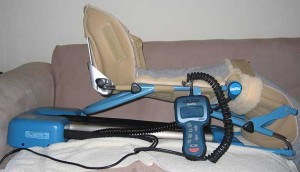Your main goals right after surgery are to get used to the feel of your new knee joint and to prepare yourself for living with your new knee. To do this, you must regain the normal movement of your knee without damaging your new joint before its muscles are strong enough to control it. Bending (flexion) and straightening (extension) are the two movements the knee joint makes. Most movements of the knee joint are controlled by the muscles of the thigh. The muscles in the front of the thigh (quadriceps) pull the leg out straight; those in the back (hamstrings) make it bend. Following surgery, your surgeon may have you use a continuous passive motion (CPM) machine. The CPM machine increases circulation, minimizes joint stiffness, and relieves muscle spasms from lack of use. A physical therapist will place the CPM machine in bed with you and fit the machine on your leg. She will adjust the motion of the machine to slowly bend and straighten your knee.

- Continuous passive motion machine for knee therapy.
Doing the special exercises the physical therapist teaches you will help:
- Stretch and strengthen your thigh muscles.
- Regain mobility (motion) in your knee.
Your leg muscles may have weakened due to lack of use resulting from your knee pain before surgery. Surgery will correct the knee problem; only exercise can strengthen the muscles. It is very important that you do all of the knee exercises your physical therapist teaches you. Regaining the strength and mobility in your knee will lead to your independence from crutches, a walker, or a cane. The following are the types of exercises you will be doing. Your therapist will tell you how many to do at a time and how many times
to do them each day.
Exercises
Straight Leg Raises strengthen the quadriceps.
1. Lie in bed on your back.
2. Bend the unaffected leg, and place your foot flat on the bed.
3. Straighten the operated leg and tighten the muscles on top of your thigh.
4. Raise the operated leg about 6 to 10 inches; hold for 5 seconds.
5. Lower your leg slowly.
6. Relax. Repeat.
Quadriceps Sets strengthen the quadriceps and stretch the hamstrings. These
muscles are important for regaining stability in your knee.
1. Lie in bed on your back.
2. Tighten the muscles on the top of the thigh of your operated leg as tight as possible while pulling your toes back (that is, point your toes toward your head) and pressing your knee downward into the bed.
3. Keep pulling with your toes for 10 seconds, pulling harder every second.
4. Relax. Repeat.
Sitting Knee Bends will maximize the range-of-motion (how much you can bend and
straighten) in your knee.
1. Sit on a chair with a rolled up towel under the operated knee.
2. Bend your knee as much as possible, then hold for 5 seconds.
3. Straighten your knee as much as possible, then hold for 5 seconds.
4. Relax. Repeat.
Knee Extensions strengthen the quadriceps.
1. Lie in bed on your back with a rolled up towel under your operated knee; let your knee bend.
2. Tighten the muscles on the top of your thigh, while lifting your heel and straightening your knee. Keep the back of your knee on the towel.
3. Hold for 5 seconds, then slowly lower your heel back to the bed.
4. Relax. Repeat.